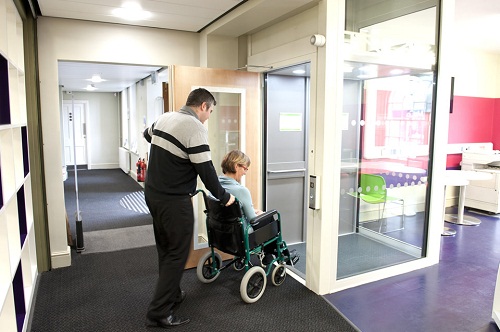Advancements in lift technology have paved way for more innovative, environmentally friendly, and more efficient installation, maintenance and operation of lifts. One such innovation is the pitless lift.
To appreciate what a pitless lift is, it is inevitable to investigate and understand what a hydraulic lift is.
A hydraulic lift is run by a piston at the bottom of the lift that pushes it up while an electric motor forces oil or a hydraulic fluid into the piston. Below the lowest landing area of the lift is a pit, which is often dug at the lowest part of the building. In some instances, a piston well is dug deeper into the ground below the pit, to serve as the receiving end of the retracting piston as the lift moves down. The lift pit serves as an area for collecting hydraulic fluid that may spill off during operation. Because of this, most pits also have a sump pump, which is either manually operated or automatically activated. The sump pump serves to drain the hydraulic fluid that has spilled from the lift. As the pit is usually found at the lowest area of the building, it is also often used to collect sprinkler water and water from janitor buckets. The sump pump gets rid of this water out of the building. The pit is also where maintenance works for the lift usually take place.
Hydraulic lifts are common in older buildings. This model was preferred by many building owners before, mainly because it was cheaper to purchase. In recent years, however, hydraulic lifts lost their popularity as more consumers preferred pitless lifts mainly for two reasons: first, pitless lifts were easier to maintain, and, second, pitless lifts posed zero environmental hazard as thesedo not use hydraulic fluids which, when drained to the ground, could potentially cause environmental hazards.
How Does A Pitless Lift Work?
Take away the use of hydraulic fluid in a lift system, and you would take away the need for a pit, thus, a pitless lift.
Pitless lifts are rising in popularity in both commercial and residential buildings. The reason for this is because pitless lifts require no digging and no massive masonry works, speeding up the installation process. Most pitless lifts can be installed in existing spaces for doorways. Using motors that are mounted in the override or along the hoist way of the lift cabin, pitless lifts are easy to install without requiring walls to be knocked down. This makes pitless lifts blend seamlessly with the existing interiors of the home or office.
Pitless Lifts Are Environment-Friendly
Eliminating the need for hydraulic fluid, pitless lifts prove to be environmentally friendly. Modern pitless lifts also use energy efficient features in terms of cabin lighting. There are even pitless lifts that can be set to sleep mode after a given time frame when there is no passenger using it, thus, lowering energy consumption.
Pitless lifts vary in load capacity, ranging from 180kgs or two persons to 630kgs or up to eight persons. Very reliable and easy to maintain, pitless lifts are a safer and more cost-efficient alternative to your mobility needs.
